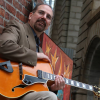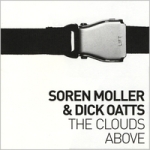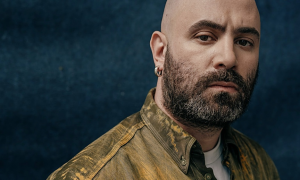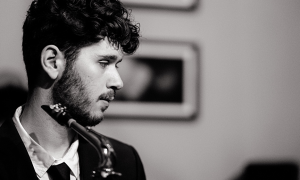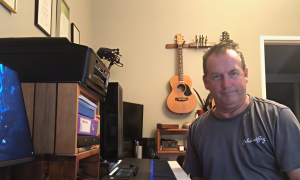Home » Jazz Articles » Take Five With... » Take Five With Rick Stone
Take Five With Rick Stone
 I've been teaching and performing in the New York area since 1982 and have had the good fortune to perform with musicians like Kenny Barron, Barry Harris, Junior Cook, Ralph Lalama, Dennis Irwin, Vernel Fournier, Eric Alexander, Peter Leitch, Sam Yahel, Mark Elf, Roni Ben-Hur, Peter Bernstein, Matt Wilson, and many, many others.
I've been teaching and performing in the New York area since 1982 and have had the good fortune to perform with musicians like Kenny Barron, Barry Harris, Junior Cook, Ralph Lalama, Dennis Irwin, Vernel Fournier, Eric Alexander, Peter Leitch, Sam Yahel, Mark Elf, Roni Ben-Hur, Peter Bernstein, Matt Wilson, and many, many others. Instrument(s):
Guitar and bass (also piano, but just enough to get into trouble)
Teachers and/or influences?
So many! I was lucky to have teachers who made me learn to read music early on; Dick Lee and Elwood Palmer at the Heights Academy of Music. Later I was inspired by Dr. Joseph Howard at Cuyahoga Community College in Parma Ohio and also took up classical guitar with George Bachmann. I also took some jazz lessons with Jose' Pochedley.
I was drawn to jazz after hearing Sonny Stitt performing live at the Smiling Dog Saloon in Cleveland. That kind of whetted my appetite and on of my Psych professors introduced me to his friend Harvey Pekar (of American Splendor fame). Harvey invited me over and played a bunch of records for me and gave me names of many players I should be checking out. That sent me on a quest to find records by Jimmy Raney, Kenny Burrell, Jim Hall, Wes Montgomery, etc.
On Joe Howard's advice I enrolled at Berklee from '79-'80 and studied with Bret Wilmott, Al Defino, Bob Harrigan and Larry Baione. Also Ken Pullig, Orville Wright, Jeff Stout and many more than I can remember. I think that experience really helped shape my idea of what being a musician was really all about.
I Came to New York in '82 and started getting a whole new education. I attended Barry Harris' classes Jazz Cultural Theatre and hung out there constantly which led to jam sessions with great musicians who used to frequent the club; Tommy Flanagan, Lionel Hampton, and many others. It was an amazing opportunity.
I knew I wanted to be a musician when...
When I was 8 years old, my friend Mitch Tabol had a birthday party. He had been taking lessons for a few months and was already playing some songs. His parents bought him a Gretsch Anniversary Model guitar and a Gibson Falcon amp. His mom had him play something for us. I can't remember what it was, but I remember seeing that guitar and thinking "I want to do THAT!"
Your sound and approach to music:
To me "sound" is what it's all about. I know that I'm very influenced by the guitarists I listened to when I first started playing jazz; Jim Hall, Jimmy Raney, Wes Montgomery, Pat Martino, etc., but I don't really try to imitate them per se. It's more about being melodic and having a kind of purity of tone. I try to "sing" through the guitar.
I write a lot of my own tunes and try to mix them up in a set with some standards, maybe take a tune in a different direction than where it's been, and play a set of music that I'd like to hear if I were the listener. In terms of a group sound, I like a kind of openness that leaves room for counterpoint and interplay. I really hate the "higher, faster, louder" mentality and prefer to play interesting music with sensitive musicians.
Your teaching approach:
An old Chinese proverb says "Give a man a fish and you feed him for a day. Teach a man to fish and you feed him for a lifetime." This is kind of my approach to teaching. I'll show a student how I play a tune, or maybe a scale, lick or phrase, but I prefer show them how THEY can go about doing these things on their own. Everybody seems to be looking for shortcuts, but the only thing that they "cut short" is themselves. The best way to build is on a solid foundation and that means a serious and intensive study of the basic skills of musicianship; playing a melody well, building good technique on the instrument, having a good understanding of theory, learning how to practice effectively, training ones ears, developing taste and sensitivity to ones musical surroundings, building a repertoire, etc. If you really want to do this, the DO it, otherwise do something else. Life's too short.
Your dream band:
Well, it's really hard to tell how a band would play together as a group until you've tried it, but I'd say Kenny Barron on piano, Eric Alexander on tenor, Eric Person on alto and soprano, Yosuke Inoue on bass, and Matt Wilson on drums.
Road story: Your best or worst experience:
Back around 1993 I was playing a gig at the New Haven Lounge in Baltimore, MD with Ralph Lalama. The club said they would supply us with rooms, so when we get there they send us to the Welcome Inn (tip: if you ever see a hotel called the "Welcome Inn" in any city, run like hell in the opposite direction).
So we go to the desk and they give us a key and we go to the building (they were like little garden apartments) and get inside to find the air conditioner is broken (this is in July and it's about 98 degrees and humid). So we go back to the desk and they give us another key. We go to check this room and it's only got ONE bed (Yikes! I like Ralph, but not like that!) Back to the desk for another key (this is starting to sound like Goldilocks, but we never really found one that was "just right"). We opened the door and it was like a "breath of air freshener" but at least the A.C. worked and there were two beds (two out of three's not bad eh?) and we figured it was the best we would get from them.
Favorite venue:
Hands down it's The Bar Next Door at La Lanterna. This is a tiny little basement club in the Village that seats all of about 28 people. JJonathan Kreisberg started the jazz their in the 90s and still plays there every Wednesday night. He brought Peter Mazza in who now does Sundays and books and MC's the other nights. They've got good food, the people treat the musicians wonderfully and Peter does a great job of making everybody feel at home. Really a nice warm vibe.
The first Jazz album I bought was:
Miles Davis Bitches Brew. I saw it in the record store when it first came out and at first it was the cover that got my attention. Later the music.
Desert Island picks:
Jim Hall These Rooms (Denon);
Jimmy Raney/Stan Getz Complete Roost Sessions (Mosaic);
John Scofield Works for Me (Verve);
Bill Evans The Complete Village Vanguard Recordings (Riverside);
Wes Montgomery The Complete Riverside Recordings (Riverside).
(Okay so I cheated with the box sets, could you really expect me to keep it down to five?)
How would you describe the state of jazz today?
Tons of amazing young musicians out there. The educational system has done great job of turning out players! I doubt that the level of musicianship has ever been higher.
At the same time, there definitely has NOT been a development of the jazz audience, so what we're seeing is shrinkage. Fewer clubs for these musicians to play regularly (which is what these musicians need if they're going to develop their own sounds and styles).
The scene is still pretty healthy here in NYC, but from conversations I've had with those in other cities, jazz is in a serious decline. Touring here in the U.S. for all but a select few has become downright impossible.
What are some of the essential requirements to keep jazz alive and growing?
I think people just need to keep playing and create their own "scene" wherever they live. Jazz seems to be thriving in Europe and Japan, so why not here?
If I weren't a jazz musician, I would be a:
Graphic designer or architect.
Tags
Rick Stone
Take Five With...
United States
Kenny Barron
Barry Harris
Eric Alexander
Sam Yahel
Mark Elf
Roni Ben-Hur
Peter Bernstein
Matt Wilson
Sonny Stitt
Jimmy Raney
Kenny Burrell
Jim Hall
Wes Montgomery
Tommy Flanagan
Lionel Hampton
Pat Martino
onathan Kreisberg
Miles Davis
Stan Getz
John Scofield
Bill Evans
PREVIOUS / NEXT
Support All About Jazz
 All About Jazz has been a pillar of jazz since 1995, championing it as an art form and, more importantly, supporting the musicians who make it. Our enduring commitment has made "AAJ" one of the most culturally important websites of its kind, read by hundreds of thousands of fans, musicians and industry figures every month.
All About Jazz has been a pillar of jazz since 1995, championing it as an art form and, more importantly, supporting the musicians who make it. Our enduring commitment has made "AAJ" one of the most culturally important websites of its kind, read by hundreds of thousands of fans, musicians and industry figures every month.


